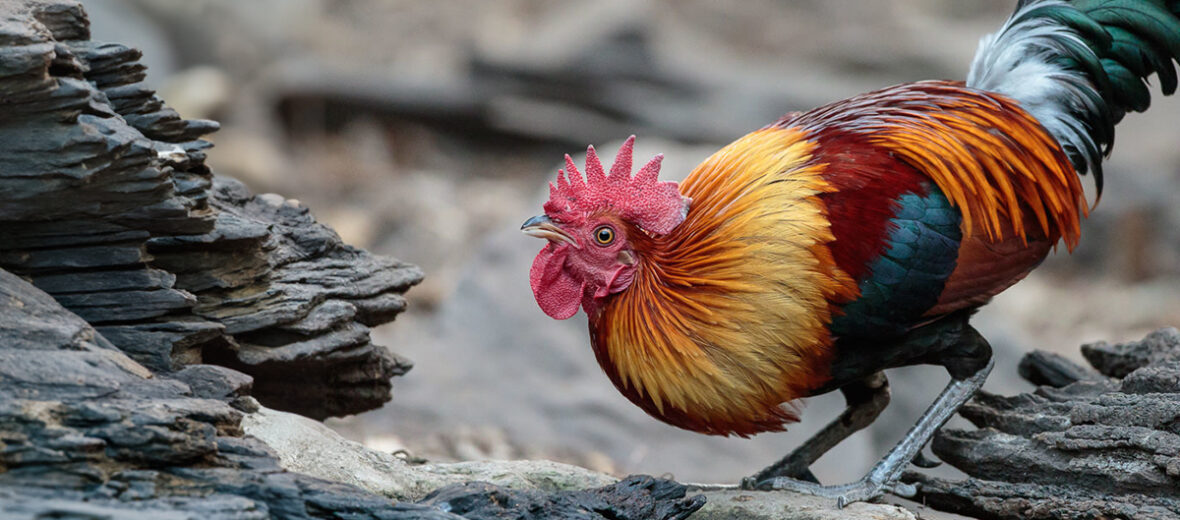
The red junglefowl is the closest relative of the domestic chicken. They can be found throughout southern and southeastern Asia, Australasia, Australia, and Hawaii. These birds prefer tropical moist forests, scrub habitats, mangroves, palm oil plantations, tea plantations, and agricultural regions. Due to the lack of threats, sans habitat loss, hunting, and trapping, as well as a wide range and speculated abundant population, these birds are listed as Least Concern by the IUCN. Their numbers are decreasing though. This article is dedicated to my friend Eleanor.
First the Stats…
Scientific name: Gallus gallus
Weight: Up to 51.1 ounces
Length: Up to 29.5 inches
Wingspan: Up to 20.1 inches
Lifespan: Up to 30 years
Now on to the Facts!
1.) While generally shy, they are social among themselves. Flocks can be found consisting of a couple males and several females.
2.) Dominance hierarchies are established between the males and the dominant males typically sport larger combs (the fleshy appendage on the top of their head).
3.) Red junglefowls are diurnal (active during the day).
4.) Dust baths are performed regularly to help balance the amount of oils in present in their feathers. The dust gathers the excess oil and falls to the ground.
5.) They have the ability to fly, but only for short distances.
But wait, there’s more on the red junglefowl!
6.) Males call via the tell-tale “cock-a-doodle-doo”. Other warning calls are also emitted to alert the others of predators.
7.) Fruits, crops, leaves, seeds, roots, tubers, various invertebrates, juvenile mice & rats, small lizards, and sometimes even the feces (poop) of mammals is all on the menu for these omnivores (eat plant and animal matter).
Did you know…?
Just like domestic roosters, the males possess a sharp spur behind and above the back of each foot.
8.) These birds are polygynous (1 male mates with multiple females in his flock).
9.) The mating ritual consists of clucking calls, coaxing, and interesting bobbing & twitching movements of the head and neck, followed by tidbitting (offering food to the female).
10.) The courting of a particular hen ends as soon as she accepts the offered food.
But wait, there’s still more on the red junglefowl!
11.) In some locales breeding takes place during the dry season, whereas in others, breeding takes place year round.
12.) Nests are constructed of grass and small sticks and built on the ground, usually in a protected area, like under a bush.
Did you know…?
Chicks are hatched precocial (self sufficient) and are able to walk and feed themselves shortly after hatching.
13.) Hens lay up to 7 eggs that hatch in up to 21 days.
14.) The chicks fledge in up to 5 weeks, and by 12 weeks they are chased out of the flock completely. At that time they will either start their own flock or will attempt to join another existing flock.
15.) Red junglefowls were domesticated over 5,000 years ago for egg production and for meat. However, the wild junglfowl is still used for both eggs and meat, as well as the horrible and brutal “sport” of cock fighting.
But wait, there’s still a tad more on the red junglefowl!
16.) Even though these birds don’t require standing water, they will still occasionally drink from pools of water if they come across them.
17.) Though not migratory, they will travel from their primary location in search of food during times of drought.
18.) The male’s 14 tail feathers can grow to 11 inches in length.
Now a Short Red Junglefowl Video!
Be sure to share & comment below! Also, check out the Critter Science YouTube channel. Videos added regularly!
Want to suggest a critter for me to write about? Let me know here.
Some source material acquired from: Wikipedia & IUCN
Photo credit: iNaturalist



